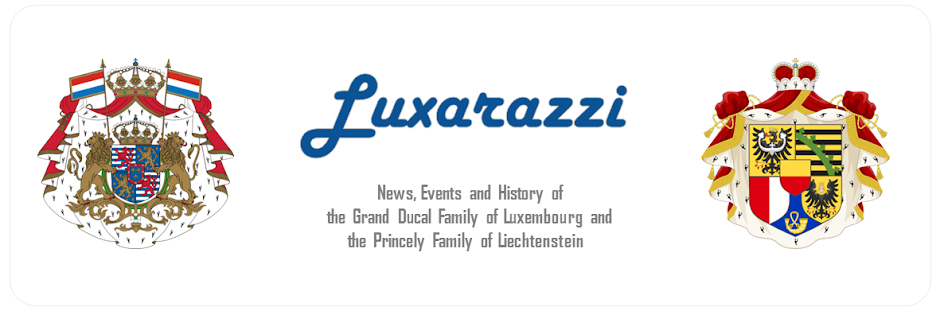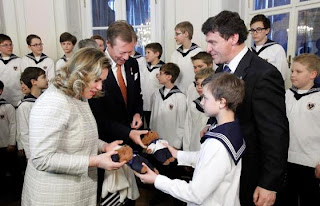Today was the big day for the new King Willem-Alexander of the Netherlands! As there is so much coverage about the abdication of his mother, now Princess Beatrix, and his investure, we are solely focusing our attention of the Luxarazzi representatives at the event, the Hereditary Grand Ducal Couple of Luxembourg as well as the Hereditary Princely Couple of Liechtenstein.
Yeah... Ermm... Humm... How nice of Stéphanie to pay tribute to the now former Queen Beatrix - can't quite get myself to simply call her Princess Beatrix yet - with her choice of hat. The rest of her outfit looks like stolen from her mother-in-laws wardrobe anno early 2000's. Memo to the Hereditary Grand Duchess: you are in your late 20's not twice that age. On the other hand, Sophie wasn't much better. That's a lot of kermit green and I never understood the shape of those hats.
So let's talk about talk-worthy stuff, the orders. While Hereditary Grand Duke Guillaume is sporting the Order of Orange-Nassau, which he received during a state visit last year, Hereditary Grand Duchess Stéphanie is wearing the Civil and Military Order of Merit of Adolph of Nassau, the second hightest order of the Grand Duchy. It appears that she hasn't gotten the Order of the Gold Lion of the House of Nassau yet.
Usually, the orders of the Grand Duchy are given out on National Day so it's entirely possible that she will get the higher order in June, though it is also entirely possible that it will take a few years before she gets it. The late Grand Duchess Joséphine-Charlotte became a member of the Gold Lion of the House of Nassau on 11 November 1964, a day before her husband became Grand Duke. For the life of me and after about two hours of searching, I can't find pictures of Grand Duchess Maria-Teresa wearing the insignia of the Gold Lion of the House of Nassau when she was still Hereditary Grand Duchess.
So, I guess we will have to wait and see. The Civil and Military Order of Merit of Adolph of Nassau is given to all members of the Grand Ducal Family without any reference - at least according to the government - whether they were born members of the family or married in.
Meanwhile, our friends from Liechtenstein are showing of their highest national order, the Order of Merit of the Principality of Liechtenstein. The principality doesn't do state visits so they have close to no foreign orders.
Pictures and videos of today are everywhere, just go to any photo agency or the NOS website.
| Photos: AFP |
So let's talk about talk-worthy stuff, the orders. While Hereditary Grand Duke Guillaume is sporting the Order of Orange-Nassau, which he received during a state visit last year, Hereditary Grand Duchess Stéphanie is wearing the Civil and Military Order of Merit of Adolph of Nassau, the second hightest order of the Grand Duchy. It appears that she hasn't gotten the Order of the Gold Lion of the House of Nassau yet.
Usually, the orders of the Grand Duchy are given out on National Day so it's entirely possible that she will get the higher order in June, though it is also entirely possible that it will take a few years before she gets it. The late Grand Duchess Joséphine-Charlotte became a member of the Gold Lion of the House of Nassau on 11 November 1964, a day before her husband became Grand Duke. For the life of me and after about two hours of searching, I can't find pictures of Grand Duchess Maria-Teresa wearing the insignia of the Gold Lion of the House of Nassau when she was still Hereditary Grand Duchess.
So, I guess we will have to wait and see. The Civil and Military Order of Merit of Adolph of Nassau is given to all members of the Grand Ducal Family without any reference - at least according to the government - whether they were born members of the family or married in.
Meanwhile, our friends from Liechtenstein are showing of their highest national order, the Order of Merit of the Principality of Liechtenstein. The principality doesn't do state visits so they have close to no foreign orders.
Pictures and videos of today are everywhere, just go to any photo agency or the NOS website.





























